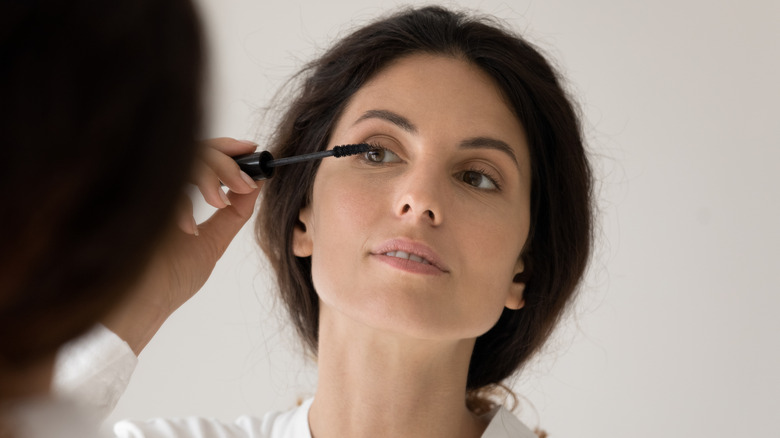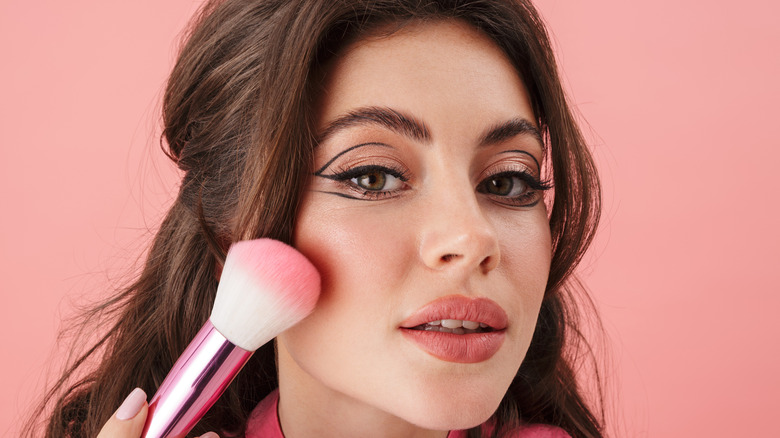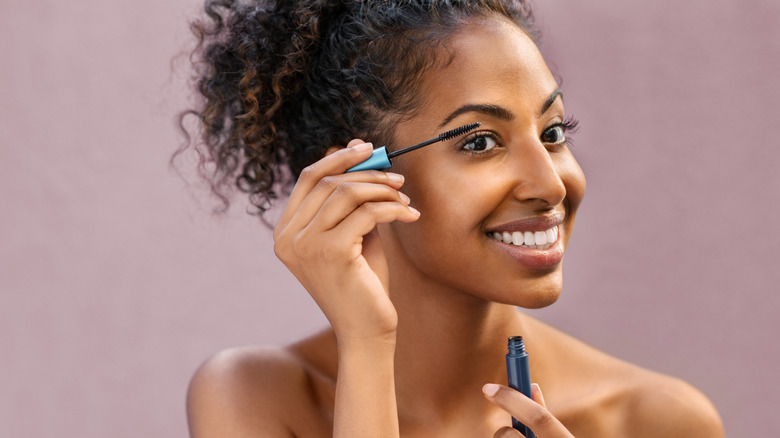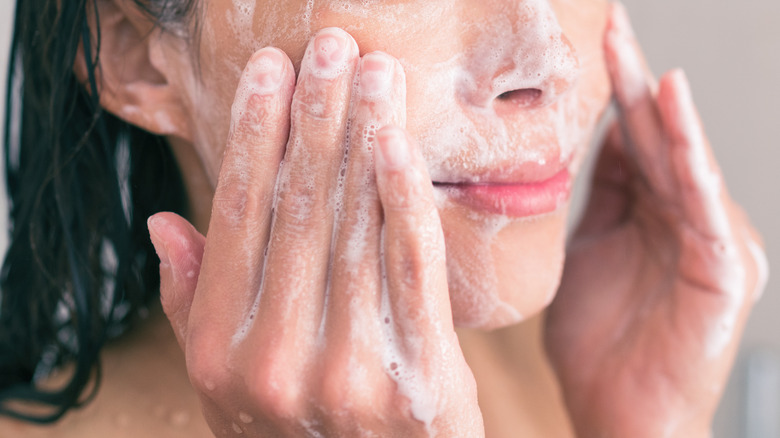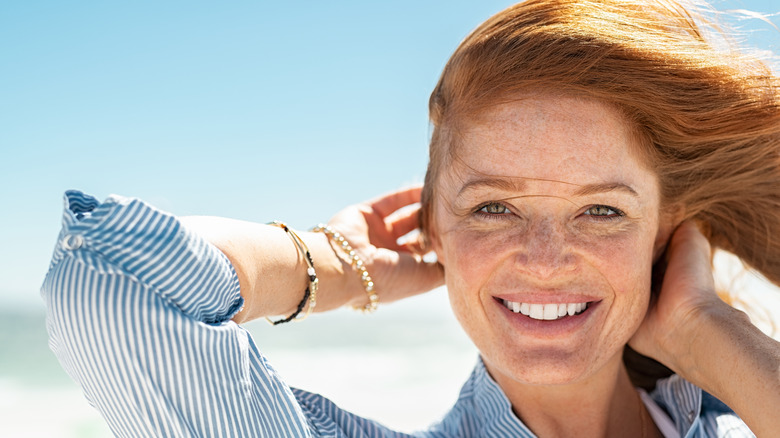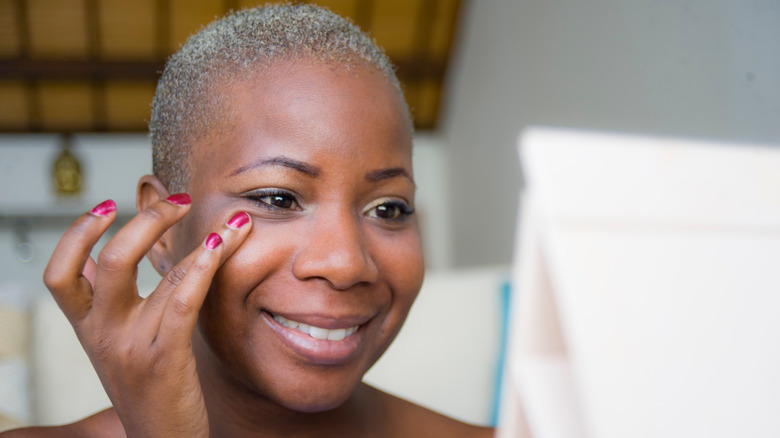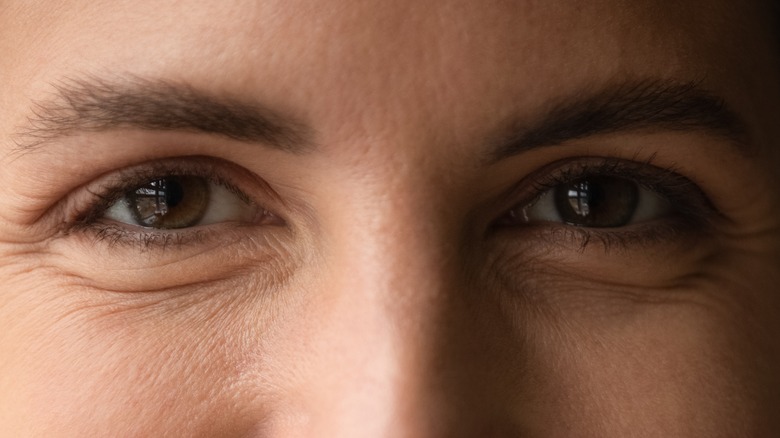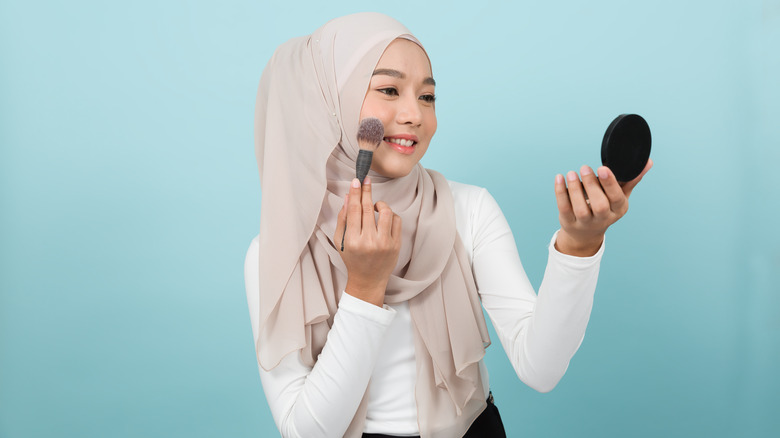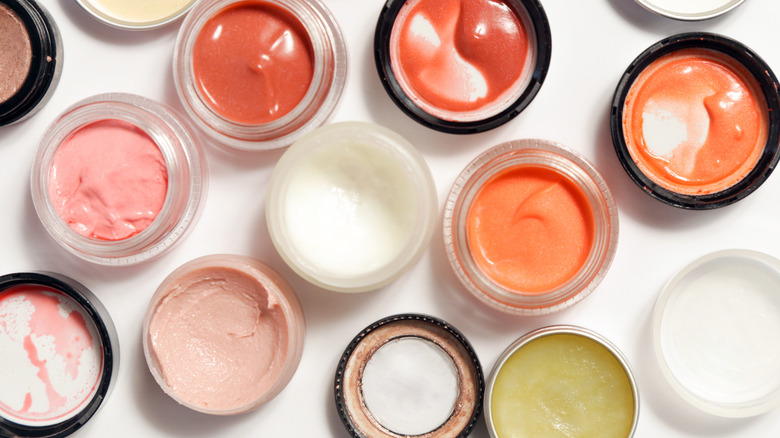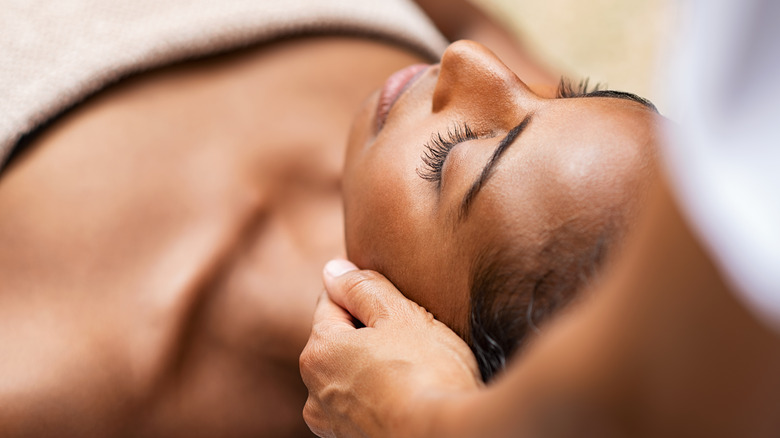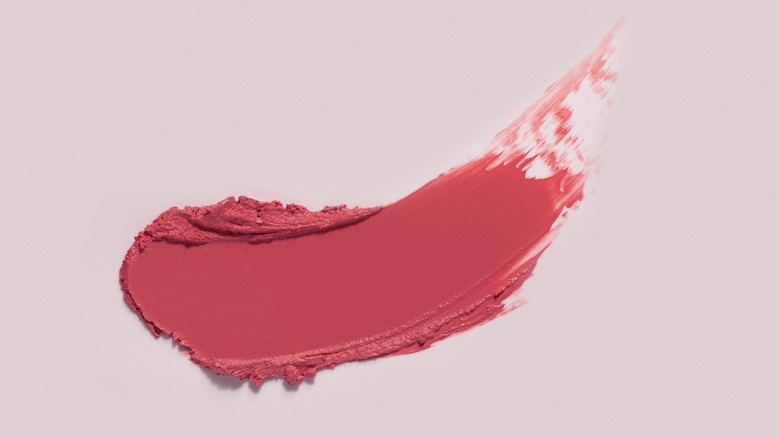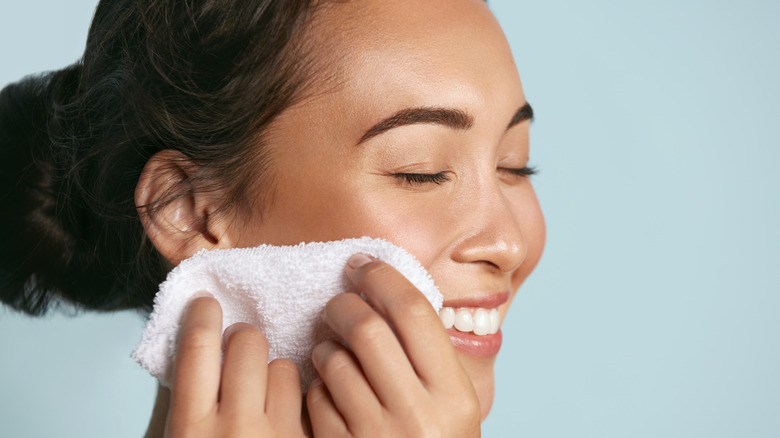How To Update Your Makeup Routine In Your 30s
We may receive a commission on purchases made from links.
It's no secret that makeup trends come and go like the fall weather — one day it's beautiful and sunny with bright lips and fluffy brows, and the next it's thundering in the dark skies with reverse cat eyes and bold contouring. Trying to stay on top of said trends, then, is like fulfilling the role of a frantic weather reporter on the first day of the job. Of course, many trending makeup looks and routines originate on social media — and can be a minefield for millennials. And though we hate to admit it, those of us born in the '80s and '90s are getting a little on in years, and our aging bodies — and inflation-riddled bank account — are feeling the pressure of the ever-demanding society we live in.
While the pandemic changed a lot of makeup-wearing habits, sticking to a tried-and-true routine establishes a sense of normalcy for so many of us. Whether it's simply throwing on some tinted moisturizer and chapstick, or executing a full beat, makeup routines are an integral part of the morning experience. And while trends come and go and makeup remains on the same carousel on which it's been for generations, you should consider revamping your makeup routine now that you're in your 30s. After all, your skin goes through many changes during this decade, and thus what you put on your face should change too.
Don't fall victim to trends
We love a day that's bookended by a makeup routine and a nightly skin care wind-down, but as you navigate your 30s, your morning products should be tailored to your own makeup needs. By this, of course, we mean that any routine-based adult who's spent the better part of two decades wearing makeup should know what works for them and what doesn't — and while we hate to break it to you, that largely means avoiding trends.
Take some of the makeup trends we're currently seeing play out in real time, as categorized by Good Housekeeping. The overly blushed cheeks and nose, for instance, are a much better fit for women in their early 20s who are bringing back Y2K fashion, not on the face of a 32-year-old professional who has her career on track. The bold graphic liner, another trending look, is great for a night out on the town or a fancy dress party, but make sure that it stays out of your makeup routine if you were born in 1990.
As celebrity makeup artist Tobi Henney told Who What Wear, "By your 30s, you should know what tones and shades suit your specific coloring. Work on figuring out what you like and what suits you, and stick to that. Makeup trends come and go, so stick to what makes you look your best!"
Avoid heavy eye makeup and stick to a light mascara and eye drops
If there's anything worse than not getting a good night's sleep, it's looking tired throughout the day. Once you hit your 30s, your eye bags can become designer. If this bothers you, you can adjust the eye makeup portion of your routine.
As noted by Gainesville Aesthetics, your 30s often mark an increase in dark eye circles and puffy bags (sorry to break it to you), as the skin around the eyes loses both collagen and elastin — two key elements that maintain that youthful glow. Additionally, the very thin skin around the eyes can suffer from poor lymph drainage, further adding to the puffiness you could see on a regular basis. Eye irritation can also occur, thanks to makeup (via Woodhams Eye Clinic). With that in mind, choose your products carefully, lay off the cakey black liquid eyeliner, and throw away products once they've aged.
Opt for a lengthening mascara that's actually easy to remove (so you can lay off the harsh makeup wipes). The Blinc Original Tubing Mascara is a winner, as it's vegan, cruelty-free, washes off easily, and makes the lashes look longer. Natural eye drops will also keep your eyes looking fresh and hydrated. Similasan USA's Dry Eye Relief offers moisture without harsh chemicals.
Exfoliation and skin care should be the priority
To revamp your makeup routine in your 30s, you should first turn your attention to skin care. When we were in our teens, makeup was used to cover up that pesky puberty acne that just would not go away — plus, we failed to see the need to take care of our skin. But you're in your 30s now! You are collected, put together, professional, and stunning! As such, you need to lock down a skin care routine — that way your makeup starts working for you, enhancing your natural beauty, rather than working against you or covering you up completely.
As noted by Healthline, one of the most important elements of a skin care routine is exfoliation. The American Academy of Dermatology notes that proper exfoliation can leave your skin looking brighter and can increase your skin's capacity to absorb all the skin care goodness that you're using as part of your routine. Exfoliating can also help increase the collagen in your skin, diminish the appearance of pores, and help get rid of fine lines. It's a win, win ... win.
And don't say that you're "too old" to change your habits. Now is the perfect time. "The growth hormones start to slow down, so the skin won't repair itself as it did in your 20s," Renée Rouleau, a celebrity esthetician, told Byrdie. "The days of neglecting your skin are over," she confirmed.
Replace the heavy foundation
Raise your hand if your first makeup haul was full of MAC products? Buying the MAC Studio Fix foundation was essentially a right of passage for so many millennials, and. But just like the days of low-rise jeans and skinny scarves are out (thank the heavens, honestly), so, too, is using a heavy foundation. Once you're in your 30s, your skin may have started to crease a little. Don't fret! We love laugh lines — they're a sign of a life well lived. But if you're opting to change up your makeup routine, celebrity makeup artist Tobi Henney suggests using a CC cream rather than a super thick foundation.
"Less is definitely more!" Henney told Who What Wear. "I find that the heavier the makeup is, the older a person looks." And, if you really want to channel "Queer Eye" star Jonathan Van Ness, mix a little bit of concealer with a moisturizer and spread that concoction all over your face. You'll get that little bit of coverage plus the benefits of skin care. What's better than that? Oh wait, we know — sunscreen!
If you're not already wearing sunscreen on your face every time you go outside, it's time to start! Premature aging is one of the things many people try to cover up with makeup, but said aging is often caused by sun exposure and damage. Avoid going outside without sunscreen — and consider adding a little concealer to your sunscreen for a perfect foundation alternative.
Choose a pore-filling primer to help even out your skin texture
A big insecurity that so many of us have as we get older is the texture of our skin. Gone are the days of a vibrant, youthful glow the morning after a night of partying. Not only does it take us longer to recover from hangovers, but our skin will certainly look like it's been through the wringer. As it turns out though, primer could be the aspect of your makeup routine that needs its time to shine, as it can fill in wrinkles and make those ever-pesky pores disappear.
"Primer will definitely make your makeup last longer. It smoothes the fine lines, evens out the skin tone, and reduces the size of your pores," celebrity makeup artist Maud Laceppe told Who What Wear. Laceppe's sentiment was echoed by Christine Cherbonnier, who served as Yoko Ono's personal makeup artist. "No matter your age, you should always choose a primer that addresses your skin type and feels good on your face. Every face is different!" Cherbonnier said. "If you have concerns about fine lines, I suggest trying a primer with a lighter weight."
Leave your eyebrows alone and highlight their natural shape
Any Y2K teen will tell you that plucking our eyebrows into almost non-existent lines was a bad idea. The upkeep was terrible, the pain was significant, and the photos are truly a terrible sight to behold. If any trend is worth paying attention to as a person in your 30s, it's the fluffy, natural eyebrow look. And while thin eyebrows might come back in fashion (we really hope they won't) a person in their 30s should opt to put the tweezers down and their natural brows alone. Brow guru Jaimineey Patel told StyleCaster that our eyebrow hair takes a significant amount of time to grow back. Even more so, the hair towards the outer arches can grow back wonky and mismatching, so it's better to tread — or thread — carefully.
If you're approaching your 30s but aren't there just yet, grow your eyebrows as much as possible now. Cheryl Renella told Women's Health Magazine that decade of life is when "hair growth is at its peak." Once you're in your 30s, your career and love life will have hopefully settled down a little bit, and if you've taken our advice, your brows will be thriving too. If you do experience some sparseness once you hit your 30s, Renella suggests turning to brow tinting. "Tinting is a great option for women at this age because it's low maintenance and it darkens brow semi-permanently," she explained.
Trade in harsh contouring for soft sculpting
For many of us in our 30s, we'd do anything to get that contoured, chiseled look that is very modelesque. But, as it turns out, such harsh contouring and highlighting could actually be making us look older, so we should revisit and revamp such practices in our makeup routine. If highlighter is used too closely to the crow's feet lines around the eyes, it could actually make those wrinkles stand out even more, makeup artist Caroline Barnes pointed out to Glamour UK. If you want that glowy look, she instead recommends putting an illuminator — this one from Saie Beauty is amazing — under your skin tint or foundation. This way, you won't be drawing the focus on your skin's imperfections, but rather glowing from within.
When it comes to contouring, you'll want to give any harsh bronzing products to your younger sister, because such definitive lines have no place in a 30-something's makeup routine. Instead, turn your attention to soft sculpting, a makeup technique that artist Mario Dedivanovic has perfected. "Today, now that everyone knows how to contour and it's become part of their everyday beauty routine, people are realizing that you can achieve a sculpted look with a lot less makeup," he told Vogue when his own soft sculpting products hit the market.
A color corrector will be your new best friend
While a regular skin care routine, sunscreen, and well-placed CC cream will do a world of good for your makeup practices, there are some blemishes and dark circles that really need an extra hand. This is where color correcting comes in — and someone in their 30s should be keenly aware of what this product could do for them.
As noted by Byrdie, there's a variety of color correcting products that range in color, and the colors indicate how they should be used. For instance, if you want to counteract the redness of a pesky pimple, using a green color corrector will balance out the inflamed pigment. Slap a little concealer on afterward, blend, and you're good to go. As far as dark circles are concerned, you're going to want to reach for a yellow color corrector. "Yellow color corrector is intended to cover and brighten purple tones coming from under the skin from visible veins, bruises, and under-eye circles," makeup artist William Scott told Byrdie. "It is best suited for people with light and warm complexions, olive skin, [and] medium-deep skin tones." For people with medium to dark complexions, an orange color corrector will do the trick, Scott added.
Scott's tip for application? Make sure that you put color-correcting products on discolored areas only. Don't treat it like a concealer that can be spread around, but more of an on-the-spot product.
Make facials and dermaplaning a part of your routine
"Photodamaged skin usually starts to appear [in your 30s] due to not using sunscreen seriously in your 20s," Kendra Joseph, certified physician assistant at Schweiger Dermatology Group, told The Zoe Report. If you didn't prevent photodamage in your 20s, facials should become a part of your routine in the self-care decade that is your 30s, as they will help counteract any damage that's already been done.
"Photodamage can range from freckles, uneven skin tone, or even a darkened face with a lighter body," Joseph explained, noting that products featuring vitamin C, ferulic acid, resveratrol, and niacinamide should be prioritized. Her sentiment was echoed by esthetician Essence Moore, who explained, "The 30s is where people are starting to see subtle changes in their skin. This is when my clients get into more machinery like the HydraFacial and microneedling to tackle anti-aging [concerns] and strengthen the skin." So, consider swapping a night out on the town for a relaxing morning at the spa — your skin will thank you.
Another element you should incorporate into your routine is dermaplaning, the act of using a small blade to help remove the "peach fuzz" and dead skin cells on the face. Self notes that dermaplaning "can make your skin look brighter, help your skin-care products sink in better, and help your foundation go on smoother" — all good things when you're in your 30s.
Cream products will serve you better than skin-drying powders
One word could stop a makeup guru in their tracks: oil. Of course, no one wants an oily face, and for that reason — and the matte-inspired looks of the early 2010s — a lot of us came into our makeup routines armed with powder compacts and fluffy brushes. While certain powder products are tried and true, 30-somethings revamping their makeup routines should try to stay clear of using too much powder. As it turns out, powder sets into any fine lines and wrinkles in the skin, and instead of keeping oil away, powder products can become cakey, drying, and can actually enhance the skin's imperfections.
"It's true that powders can create a beautiful velvet complexion, but they can also make dry skin very obvious, and slightly age the skin," makeup artist Caroline Barnes explained to The Telegraph. "Rather than powder your whole face, think about your powder placement and use a slightly smaller brush to apply powder over the T-zone only."
Consider focusing your attention on cream-based products and use a setting spray instead of powder to help lock your makeup into place. And if you're feeling a little oily while out and about, keep blotting paper in your bag rather than a travel powder compact. This way, you'll be removing the oil rather than masking it.
Make sure you're removing your makeup fully
Removing your makeup is just as important as wearing the right makeup. In fact, this is by far one of the most crucial elements that should be in your routine by the time you're in your 30s. Make sure you're completely removing your makeup at the end of the day.
Friends, this is not college, we can't get away with sleeping in a face full of makeup after a night out and hoping that our skin doesn't break out the next day. Skin care is vital — not only does keeping cakey makeup on clog your pores but leaving on eyeshadow, liner, and mascara can irritate your eyes, leading to redness. At the end of the day, taking an extra five minutes in the bathroom will change your skin for the better, and there are a few key areas you should pay extra attention to.
Dermatologist Ranella Hirsch shared with Glamour that one of the areas most people accidentally miss while removing their makeup is the eyelids, where mascara and eyeliner can gather in clumpy messes. Make sure to also pay extra attention to the hairline, as foundation and face products can build up there without you even realizing it.
